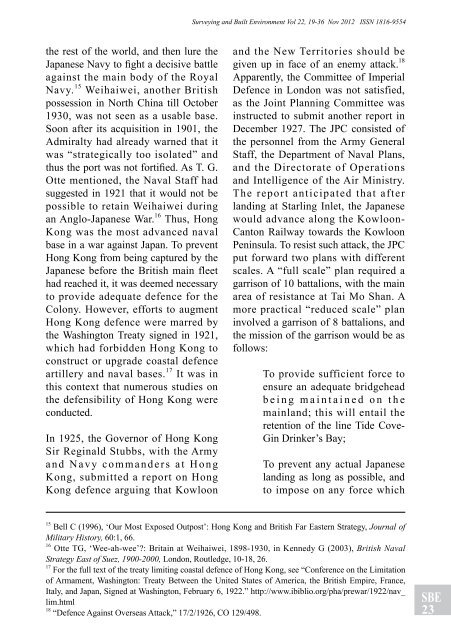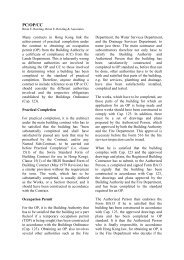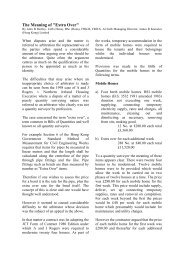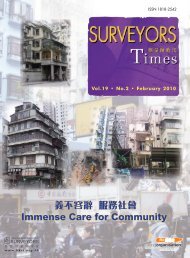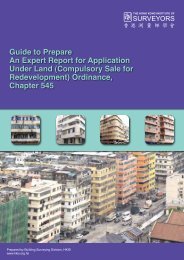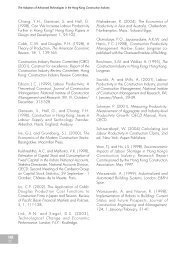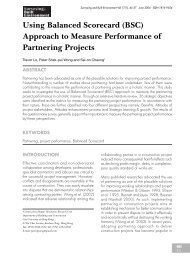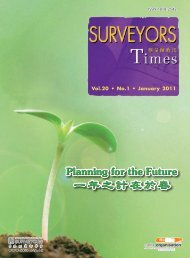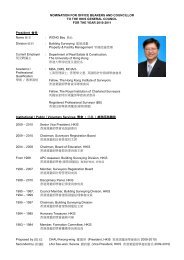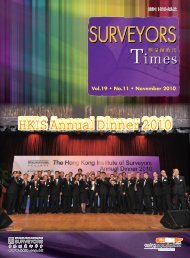Surveying & Built Environment Vol. 22 Issue 1 (December 2012)
Surveying & Built Environment Vol. 22 Issue 1 (December 2012)
Surveying & Built Environment Vol. 22 Issue 1 (December 2012)
Create successful ePaper yourself
Turn your PDF publications into a flip-book with our unique Google optimized e-Paper software.
the rest of the world, and then lure the<br />
Japanese Navy to fight a decisive battle<br />
against the main body of the Royal<br />
Navy. 15 Weihaiwei, another British<br />
possession in North China till October<br />
1930, was not seen as a usable base.<br />
Soon after its acquisition in 1901, the<br />
Admiralty had already warned that it<br />
was “strategically too isolated” and<br />
thus the port was not fortified. As T. G.<br />
Otte mentioned, the Naval Staff had<br />
suggested in 1921 that it would not be<br />
possible to retain Weihaiwei during<br />
an Anglo-Japanese War. 16 Thus, Hong<br />
Kong was the most advanced naval<br />
base in a war against Japan. To prevent<br />
Hong Kong from being captured by the<br />
Japanese before the British main fleet<br />
had reached it, it was deemed necessary<br />
to provide adequate defence for the<br />
Colony. However, efforts to augment<br />
Hong Kong defence were marred by<br />
the Washington Treaty signed in 1921,<br />
which had forbidden Hong Kong to<br />
construct or upgrade coastal defence<br />
artillery and naval bases. 17 It was in<br />
this context that numerous studies on<br />
the defensibility of Hong Kong were<br />
conducted.<br />
In 1925, the Governor of Hong Kong<br />
Sir Reginald Stubbs, with the Army<br />
and Navy commanders at Hong<br />
Kong, submitted a report on Hong<br />
Kong defence arguing that Kowloon<br />
<strong>Surveying</strong> and <strong>Built</strong> <strong>Environment</strong> <strong>Vol</strong> <strong>22</strong>, 19-36 Nov <strong>2012</strong> ISSN 1816-9554<br />
and the New Territories should be<br />
given up in face of an enemy attack. 18<br />
Apparently, the Committee of Imperial<br />
Defence in London was not satisfied,<br />
as the Joint Planning Committee was<br />
instructed to submit another report in<br />
<strong>December</strong> 1927. The JPC consisted of<br />
the personnel from the Army General<br />
Staff, the Department of Naval Plans,<br />
and the Directorate of Operations<br />
and Intelligence of the Air Ministry.<br />
The report anticipated that after<br />
landing at Starling Inlet, the Japanese<br />
would advance along the Kowloon-<br />
Canton Railway towards the Kowloon<br />
Peninsula. To resist such attack, the JPC<br />
put forward two plans with different<br />
scales. A “full scale” plan required a<br />
garrison of 10 battalions, with the main<br />
area of resistance at Tai Mo Shan. A<br />
more practical “reduced scale” plan<br />
involved a garrison of 8 battalions, and<br />
the mission of the garrison would be as<br />
follows:<br />
To provide sufficient force to<br />
ensure an adequate bridgehead<br />
being maintained on the<br />
mainland; this will entail the<br />
retention of the line Tide Cove-<br />
Gin Drinker’s Bay;<br />
To prevent any actual Japanese<br />
landing as long as possible, and<br />
to impose on any force which<br />
15<br />
Bell C (1996), ‘Our Most Exposed Outpost’: Hong Kong and British Far Eastern Strategy, Journal of<br />
Military History, 60:1, 66.<br />
16<br />
Otte TG, ‘Wee-ah-wee’?: Britain at Weihaiwei, 1898-1930, in Kennedy G (2003), British Naval<br />
Strategy East of Suez, 1900-2000, London, Routledge, 10-18, 26.<br />
17<br />
For the full text of the treaty limiting coastal defence of Hong Kong, see “Conference on the Limitation<br />
of Armament, Washington: Treaty Between the United States of America, the British Empire, France,<br />
Italy, and Japan, Signed at Washington, February 6, 19<strong>22</strong>.” http://www.ibiblio.org/pha/prewar/19<strong>22</strong>/nav_<br />
lim.html<br />
18<br />
“Defence Against Overseas Attack,” 17/2/1926, CO 129/498.<br />
SBE<br />
23


